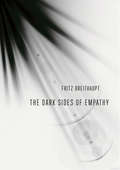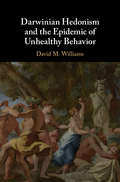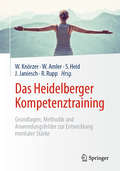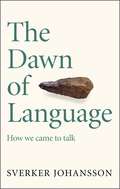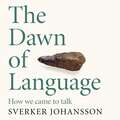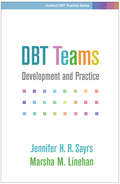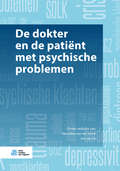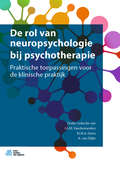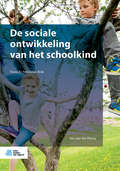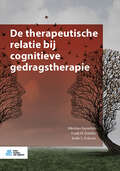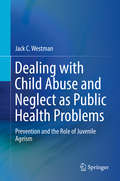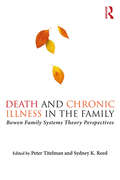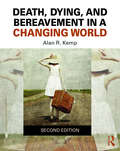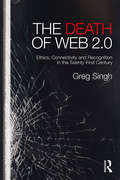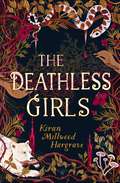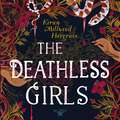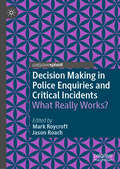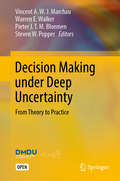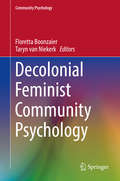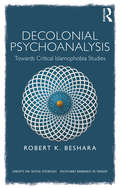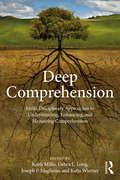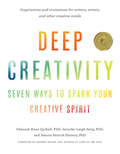- Table View
- List View
The Dark Sides of Empathy
by Fritz BreithauptMany consider empathy to be the basis of moral action. However, the ability to empathize with others is also a prerequisite for deliberate acts of humiliation and cruelty. In The Dark Sides of Empathy, Fritz Breithaupt contends that people often commit atrocities not out of a failure of empathy but rather as a direct consequence of over-identification and a desire to increase empathy. Even well-meaning compassion can have many unintended consequences, such as intensifying conflicts or exploiting others.Empathy plays a central part in a variety of highly problematic behaviors. From mere callousness to terrorism, exploitation to sadism, and emotional vampirism to stalking, empathy all too often motivates and promotes malicious acts. After tracing the development of empathy as an idea in German philosophy, Breithaupt looks at a wide-ranging series of case studies—from Stockholm syndrome to Angela Merkel's refugee policy and from novels of the romantic era to helicopter parents and murderous cheerleader moms—to uncover how narcissism, sadism, and dangerous celebrity obsessions alike find their roots in the quality that, arguably, most makes us human.
Darwinian Hedonism and the Epidemic of Unhealthy Behavior
by David M. WilliamsPsychological hedonism - the idea that people tend to act in ways that maximize pleasure and minimize displeasure - has a decidedly poor reputation among academics who study human behavior. Opinions range from outright rejection to those who believe it to be intuitively obvious, but untestable and therefore unhelpful. In this book, the author introduces an empirically testable and useful theory of psychological hedonism based on contemporary theory and research in the emerging field of affective neuroscience. He goes on to argue that people are genetically endowed with a tendency towards psychological hedonism as a function of Darwinian processes. This view of psychological hedonism in light of its Darwinian origins - thereinafter referred to as Darwinian hedonism - is essential to address the growing global epidemic of unhealthy behavior, such as poor diet, physical inactivity, and substance use.
Das Heidelberger Kompetenztraining: Grundlagen, Methodik und Anwendungsfelder zur Entwicklung mentaler Stärke
by Wolfgang Knörzer Wolfgang Amler Sarah Heid Julia Janiesch Robert RuppWie kann man Menschen dazu befähigen, komplexe Anforderungssituationen zu bewältigen und ihre optimalen Leistungen punktgenau abzurufen? Das Heidelberger Kompetenztraining zur Entwicklung mentaler Stärke (HKT) ist genau auf diese Fragestellung hin entwickelt worden. Es führt persönlichkeitsstärkende Lehr- und Lernmethoden mit Mentaltraining im Sport zusammen. In diesem Buch werden sowohl die theoretischen Grundlagen und Methoden als auch Anwendungsfelder und die Implementierung beschrieben. Es richtet sich damit an alle, die Problemlösungskompetenzen stärken und andere Menschen dabei unterstützen möchten.
The Dawn of Language: The story of how we came to talk
by Sverker Johansson"A model of popular-science writing" STEVEN POOLEWho was "the first speaker" and what was their first message?An erudite, tightly woven and beautifully written account of one of humanity's greatest mysteries - the origins of language.Drawing on evidence from many fields, including archaeology, anthropology, neurology and linguistics, Sverker Johansson weaves these disparate threads together to show how our human ancestors evolved into language users. The Dawn of Language provides a fascinating survey of how grammar came into being and the differences or similarities between languages spoken around the world, before exploring how language eventually emerged in the very remote human past.Our intellectual and physiological changes through the process of evolution both have a bearing on our ability to acquire language. But to what extent is the evolution of language dependent on genes, or on environment? How has language evolved further, and how is it changing now, in the process of globalisation? And which aspects of language ensure that robots are not yet intelligent enough to reconstruct how language has evolved? Johansson's far-reaching, authoritative and research-based approach to language is brought to life through dozens of astonishing examples, both human and animal, in a fascinatingly erudite and entertaining volume for anyone who has ever contemplated not just why we speak the way we do, but why we speak at all.Translated from the Swedish by Frank Perry
The Dawn of Language: The story of how we came to talk
by Sverker JohanssonAn erudite, tightly woven and beautifully written account of one of humanity's greatest mysteries - the origins of language.Who was "the first speaker" and what was their first message?Drawing on evidence from many fields, including archaeology, anthropology, neurology and linguistics, Sverker Johansson weaves these disparate threads together to show how our human ancestors evolved into language users. The Dawn of Language provides a fascinating survey of how grammar came into being and the differences or similarities between languages spoken around the world, before exploring how language eventually emerged in the very remote human past.Our intellectual and physiological changes through the process of evolution both have a bearing on our ability to acquire language. But to what extent is the evolution of language dependent on genes, or on environment? How has language evolved further, and how is it changing now, in the process of globalisation? And which aspects of language ensure that robots are not yet intelligent enough to reconstruct how language has evolved? Johansson's far-reaching, authoritative and research-based approach to language is brought to life through dozens of astonishing examples, both human and animal, in a fascinatingly erudite and entertaining volume for anyone who has ever contemplated not just why we speak the way we do, but why we speak at all.Sverker Johansson's claim to fame otherwise is to have invented the LSJBot, which has written 8% of all articles on Swedish Wikipedia. He is also a physicist, has conducted research at CERN and participated in EVOLANG, a leading international research conference on language.TRANSLATED FROM THE SWEDISH BY FRANK PERRY(P) 2021 Quercus Editions Limited
The Dawn of Language: The story of how we came to talk
by Sverker Johansson"A model of popular-science writing" STEVEN POOLEWho was "the first speaker" and what was their first message?An erudite, tightly woven and beautifully written account of one of humanity's greatest mysteries - the origins of language.Drawing on evidence from many fields, including archaeology, anthropology, neurology and linguistics, Sverker Johansson weaves these disparate threads together to show how our human ancestors evolved into language users. The Dawn of Language provides a fascinating survey of how grammar came into being and the differences or similarities between languages spoken around the world, before exploring how language eventually emerged in the very remote human past.Our intellectual and physiological changes through the process of evolution both have a bearing on our ability to acquire language. But to what extent is the evolution of language dependent on genes, or on environment? How has language evolved further, and how is it changing now, in the process of globalisation? And which aspects of language ensure that robots are not yet intelligent enough to reconstruct how language has evolved? Johansson's far-reaching, authoritative and research-based approach to language is brought to life through dozens of astonishing examples, both human and animal, in a fascinatingly erudite and entertaining volume for anyone who has ever contemplated not just why we speak the way we do, but why we speak at all.Translated from the Swedish by Frank Perry
DBT® Teams: Development and Practice (Guilford DBT® Practice Series)
by Jennifer H. Sayrs Marsha M. LinehanThe treatment team is an essential component of dialectical behavior therapy (DBT). This much-needed resource from Jennifer H. R. Sayrs and DBT originator Marsha M. Linehan explains how DBT teams work, ways in which they differ from traditional consultation teams, and how to establish an effective team culture. The book addresses the role of the DBT team leader; the structure of meetings; the use of DBT strategies within teams; identifying and resolving common team problems; and important functions before, during, and after suicide crises. User-friendly features include end-of-chapter exercises and reproducible handouts and forms. Purchasers get access to a Web page where they can download and print the reproducible materials in a convenient 8 1/2" x 11" size.
De dokter en de patiënt met psychische problemen
by Henriëtte van der Horst Jim Van OsDit boek is geschreven voor huisartsen die samen met de praktijkondersteuner GGZ mensen met psychische problemen behandelen en begeleiden. Het boek biedt hen handvatten voor diagnostiek, behandeling en verwijzing. De auteurs illustreren dit aan de hand van uitgewerkte casuïstiek.In het eerste deel van De dokter en de patiënt met psychische problemen staan de belangrijkste ontwikkelingen in de GGZ beschreven. Daarbij formuleren de auteurs de algemene uitgangspunten voor diagnostiek bij mensen met psychische klachten en problemen. In het boek komen ook de ‘nieuwe GGZ’ en de herstelbeweging en de ontwikkelingen op het gebied van E-mental health aan de orde.In het tweede deel leest u over veelvoorkomende psychische klachten en problemen bij patiënten. Hier worden huisartsen vrijwel dagelijks mee geconfronteerd. In deze hoofdstukken bieden huisartsen en psychiaters een aantal handvatten voor diagnostiek, behandeling en verwijzing.Verschillende huisartsen en psychiaters hebben meegewerkt aan De dokter en de patiënt met psychische problemen. Het boek staat onder redactie van prof. dr. Henriëtte van der Horst, hoogleraar huisartsgeneeskunde en ouderengeneeskunde en prof. dr. Jim van Os, hoogleraar psychiatrie.
De rol van neuropsychologie bij psychotherapie: Praktische toepassingen voor de klinische praktijk
by J.A.M. Vandermeulen M.M.A. Derix A. Van DijkeDit boek laat zien hoe neuropsychologische problematiek kan interfereren bij psychotherapeutische behandeling. Door hier meer op te focussen, kun je effectiever behandelen en misdiagnostiek voorkomen. Het beschrijft welke problemen je kan tegenkomen bij de behandeling, en welke kennis van neuropsychologische stoornissen nodig is bij aanvang en tijdens de behandeling. Tevens biedt het boek praktische handvatten voor de behandeling in de klinische praktijk. De rol van neuropsychologie in de psychotherapie is opgebouwd uit drie delen. Het algemene gedeelte gaat over de relatie tussen psychotherapie en neurowetenschappen, over kwetsbaarheid en veerkracht en over ontwikkelingsneuropsychologische perspectieven. In het tweede praktijkgericht deel komen de meest voorkomende psychische en psychiatrische problemen aan de orde, zoals depressie, chronische vermoeidheid, posttraumatisch stressstoornissen, ADHD en somatische symptoomstoornissen. Ook leest u over de mogelijke inzet van E-health bij de behandeling van deze patiënten. Deel drie, het tweede praktijkgerichte deel, richt zich op de gevolgen van niet aangeboren hersenletsel (NAH), zoals de identiteit na een NAH, beperkte cognitieve stoornissen, emotionele problemen en gesprekstherapie na hersenletsel. Daarnaast komt ook de mogelijke inzet van E-health bij behandeling van NAH aan de orde. Het boek richt zich op psychologen, psychotherapeuten en psychiaters werkzaam in de ggz. Het boek is eveneens goed bruikbaar binnen de diverse ggz-opleidingen.
De sociale ontwikkeling van het schoolkind
by Jan van der PloegDit boek beschrijft de sociale ontwikkeling van kinderen van 4 tot 12 jaar. Het laat zien hoe de sociale ontwikkeling verloopt en hoe opvoeders die kunnen beïnvloeden. Het boek is geschreven voor iedereen die werkt met schoolgaande kinderen, zoals leerkrachten, intern begeleiders, remedial teachers, schoolpsychologen en professionals in de jeugdzorg. Ook is het geschikt voor iedereen die nog in opleiding is voor zulk werk, en natuurlijk voor ouders die geïnteresseerd zijn in de sociale ontwikkeling van hun schoolgaande kind. De sociale ontwikkeling van het schoolkind beschrijft verschillende typen relaties tussen kinderen onderling. De betekenis van die relaties is jarenlang sterk onderschat, maar ze vormen een centraal en onmisbaar aspect van de sociale ontwikkeling. Dit boek geeft praktisch en helder antwoord op vragen als: wat houden deze relaties in? Waarom hebben sommige kinderen geen of negatieve relaties? En hoe dragen deze relaties bij aan het ontstaan van prosociaal of antisociaal gedrag? Ook gaat het boek in op andere factoren die van invloed zijn op de sociale ontwikkeling, zoals de sociaaleconomische positie, de genen en het brein. Jan van der Ploeg is emeritus hoogleraar Orthopedagogiek aan de Universiteit Leiden. Hij is auteur van meerdere boeken, zoals Eenzaamheid bij jeugdigen, Agressie bij kinderen en Behandeling van Gedragsproblemen.
De therapeutische relatie bij cognitieve gedragstherapie
by Nikolaos Kazantzis Frank M. Dattilio Keith S. DobsonDit boek laat zien hoe de therapeutische relatie in de cognitieve gedragstherapie (CGT) kan worden ingezet om verandering te weeg te brengen. Het beschrijft onder andere hoe casusconceptualisatie gebruikt kan worden om te beslissen wanneer relatieproblemen moeten worden aangepakt, welke specifieke strategieën moeten worden gebruikt (bijvoorbeeld het uiten van empathie of het vragen van feedback aan cliënten) en hoe therapeuten kunnen omgaan met hun eigen emotionele reacties tijdens een therapiesessie. De therapeutische relatie bij cognitieve gedragstherapie legt daarnaast uit hoe samenwerking, empirisme en de socratische dialoog kunnen worden versterkt en de resultaten kunnen worden verbeterd. Speciale onderwerpen die aan bod komen zijn onder andere het verbeteren van de therapeutische relatie bij paren, gezinnen, groepen, kinderen en adolescenten. De therapeutische relatie bij cognitieve gedragstherapie is toegankelijk geschreven, biedt praktische klinische aanbevelingen, veel casuïstiek, werkbladen en een groot aantal oefeningen.
Dealing with Child Abuse and Neglect as Public Health Problems: Prevention and the Role of Juvenile Ageism
by Jack C. WestmanThis thought-provoking volume defines child abuse and neglect as a public health crisis, both in terms of injuries and mental health problems and as a link to poverty and other negative social outcomes. The author identifies key factors contributing to this situation—in particular juvenile ageism, the pervasive othering of children and youth—coupled with the assumption of parental competence until severe abuse or neglect proves otherwise. The book’s practical answers to these complex issues involve recognizing and balancing the rights of parents and children, and responding to the diverse needs of new, competent, and dysfunctional families. To this end, a comprehensive prevention model is outlined, featuring primary, secondary, and tertiary interventions.Included in the coverage:• Child abuse and neglect in the United States• The impact of juvenile ageism on individuals• The devaluation of parenthood• The rights and needs of newborn babies and young children• Overcoming our crisis-recoil response• Barriers to change and hope for the futureDealing with Child Abuse and Neglect as Public Health Problems should engage professionals in the public health, healthcare, and social services sectors. It should also attract parents in struggling families as well as other laypersons, such as policymakers and child advocates, interested in improving current social conditions.
Death and Chronic Illness in the Family: Bowen Family Systems Theory Perspectives
by Peter Titelman Sydney K. ReedWhat does it mean to be ‘present and accounted for’ when a family member is facing chronic illness or death? How does one define a self in relation to the ill or dying member and the family? Rooted in Murray Bowen’s family systems theory, this edited volume provides conceptual ideas and applications useful to clinicians who work with families facing chronic illness or the death of a member. The text is divided into four parts: Part I provides a detailed overview of Bowen’s theory perspectives on chronic illness and death and includes Murray Bowen’s seminal essay "Family Reaction to Death." In Parts II and III, chapter authors draw upon Bowen theory to intimately explore their families' reactions to and experiences with death and chronic illness. The final part uses case studies from contributors’ clinical practices to aid therapists in using Bowen systems perspectives in their work with clients. The chapters in this volume provide a rich and broad range of clinical application and personal experience by professionals who have substantial knowledge of and training in Bowen theory. Death and Chronic Illness in the Family is an essential resource for those interested in understanding the impact of death and loss in their professional work and in their personal lives.
Death and Dying, Life and Living
by Kenneth J. Doka Charles A. Corr Donna M. CorrPractical and inspiring, this best-selling book helps students learn to cope with encounters with death, dying, and bereavement. The authors integrate classical and contemporary material, present task-based approaches for individual and family coping, and include four substantial chapters devoted to death-related issues faced by children, adolescents, adults, and the elderly. In addition, the text discusses a variety of cultural and religious perspectives that impact individuals' understandings and practices associated with such encounters. The book also offers practical guidelines for constructive communication designed to encourage productive living in the face of death.
Death, Dying, and Bereavement in a Changing World (Second Edition)
by Alan R. Kemp<p>In this introductory text on thanatology, Alan Kemp continues the first edition’s trajectory of taking on the central question of mortality: the centrality of death coupled with the denial of death in the human experience. Drawing from the work of Ernest Becker, Death, Dying, and Bereavement in a Changing World provides a multidisciplinary and multidimensional approach to the study of death, putting extra emphasis on the how death takes place in a rapidly changing world. <p>This new, second edition includes the most up-to-date research, data, and figures related to death and dying. New research on the alternative death movement, natural disaster related deaths, and cannabis as a form of treatment for life-threatening illnesses, and updated research on physician assisted suicide, as well as on grief as it relates to the DSM-5 have been added.</p>
The Death of Web 2.0: Ethics, Connectivity and Recognition in the Twenty-First Century
by Greg SinghWith all our contemporary connectivity, are we really connected? What does the nature of connectivity tell us about interpersonal and community relationships? What ethical concerns are raised through an always-on culture? Communication in today’s world is characterised by a condition of persistent, semi-permanent connectivity, which seems to bring us closer together, but which can also be profoundly alienating. The Death of Web 2.0 takes a retrospective look at a moment in recent media history that has had, and will continue to have, a lasting impact upon the predominant attitude towards cultures of connectivity. Greg Singh draws from a range of approaches, intellectual traditions and scholarly disciplines to engage key questions underpinning the contemporary communications media ecosystem. Bringing together influences from communitarian ethics, recognition theory and relational and depth psychology, Singh synthesises key approaches to produce a critical inquiry that projects the tensions at the heart of connectivity as a principle of Web 2.0. He argues that Web 2.0 is a cultural moment that is truly over, and that what is popularly described as 'Web 2.0' is an altogether different set of principles and practices. The Death of Web 2.0 recognises the consequences of our 'always-on' culture, where judgments are made quickly and where impacts can be far-reaching, affecting our relationships, wellbeing, mental health and the health of our communities, and it concludes by asking what an ethics of connectivity would look like. This unique interdisciplinary work will be essential reading for academics and students of Jungian and post-Jungian studies, media and cultural studies and psychosocial studies as well as anyone interested in the social implications of new media.
The Deathless Girls
by Kiran Millwood HargraveGothic, intoxicating, feminist, darkly provoking and deeply romantic - this is the breathtakingly imagined untold story of the brides of Dracula, by bestselling author Kiran Millwood Hargrave in her much-anticipated YA debut.They say the thirst of blood is like a madness - they must sate it. Even with their own kin.On the eve of her divining, the day she'll discover her fate, seventeen-year-old Lil and her twin sister Kizzy are captured and enslaved by the cruel Boyar Valcar, taken far away from their beloved traveller community. Forced to work in the harsh and unwelcoming castle kitchens, Lil is comforted when she meets Mira, a fellow slave who she feels drawn to in a way she doesn't understand. But she also learns about the Dragon, a mysterious and terrifying figure of myth and legend who takes girls as gifts. They may not have had their divining day, but the girls will still discover their fate...
The Deathless Girls
by Kiran Millwood HargraveGothic, intoxicating, feminist, darkly provoking and deeply romantic - this is the breathtakingly imagined untold story of the brides of Dracula, by bestselling author Kiran Millwood Hargrave in her much-anticipated YA debut.They say the thirst of blood is like a madness - they must sate it. Even with their own kin.On the eve of her divining, the day she'll discover her fate, seventeen-year-old Lil and her twin sister Kizzy are captured and enslaved by the cruel Boyar Valcar, taken far away from their beloved traveller community. Forced to work in the harsh and unwelcoming castle kitchens, Lil is comforted when she meets Mira, a fellow slave who she feels drawn to in a way she doesn't understand. But she also learns about the Dragon, a mysterious and terrifying figure of myth and legend who takes girls as gifts. They may not have had their divining day, but the girls will still discover their fate...
The Deathless Girls
by Kiran Millwood HargraveGothic, intoxicating, feminist, darkly provoking and deeply romantic - this is the breathtakingly imagined untold story of the brides of Dracula, by bestselling author Kiran Millwood Hargrave in her much-anticipated YA debut.They say the thirst of blood is like a madness - they must sate it. Even with their own kin.On the eve of her divining, the day she'll discover her fate, seventeen-year-old Lil and her twin sister Kizzy are captured and enslaved by the cruel Boyar Valcar, taken far away from their beloved traveller community. Forced to work in the harsh and unwelcoming castle kitchens, Lil is comforted when she meets Mira, a fellow slave who she feels drawn to in a way she doesn't understand. But she also learns about the Dragon, a mysterious and terrifying figure of myth and legend who takes girls as gifts. They may not have had their divining day, but the girls will still discover their fate...(P)2019 Hodder & Stoughton Limited
Decision Making in Police Enquiries and Critical Incidents: What Really Works?
by Mark Roycroft Jason RoachThis book examines how the police make decisions in real life situations, particularly in major enquiries. The two key themes explored are real-time decision making along with what “works” in such circumstances. It aims to set out how successful decisions are arrived at in a variety of difficult and time-constrained situations and discusses the lessons that can be learnt from this. Written by practitioners and academics, the book explores a range of topics, from the decision making process involved operational matters and in difficult-so-solve murder enquiries. It not only examines decision making but also how experienced decision makers function. It looks at the psychology of police decision making, decision making involved in cold case investigations, and discusses the need for “grip” during major investigations. The contributors are experienced and respected practitioners and academics This book will appeal particularly to those studying Policing and Criminology and also to Investigating Officers and those involved in professionalising investigative practice.
Decision Making under Deep Uncertainty: From Theory To Practice
by Steven W. Popper Warren E. Walker Vincent A. W. J. Marchau Pieter J. T. M. BloemenThis open access book focuses on both the theory and practice associated with the tools and approaches for decisionmaking in the face of deep uncertainty. It explores approaches and tools supporting the design of strategic plans under deep uncertainty, and their testing in the real world, including barriers and enablers for their use in practice. The book broadens traditional approaches and tools to include the analysis of actors and networks related to the problem at hand. It also shows how lessons learned in the application process can be used to improve the approaches and tools used in the design process. The book offers guidance in identifying and applying appropriate approaches and tools to design plans, as well as advice on implementing these plans in the real world. For decisionmakers and practitioners, the book includes realistic examples and practical guidelines that should help them understand what decisionmaking under deep uncertainty is and how it may be of assistance to them. <p><p> Decision Making under Deep Uncertainty: From Theory to Practice is divided into four parts. Part I presents five approaches for designing strategic plans under deep uncertainty: Robust Decision Making, Dynamic Adaptive Planning, Dynamic Adaptive Policy Pathways, Info-Gap Decision Theory, and Engineering Options Analysis. Each approach is worked out in terms of its theoretical foundations, methodological steps to follow when using the approach, latest methodological insights, and challenges for improvement. In Part II, applications of each of these approaches are presented. Based on recent case studies, the practical implications of applying each approach are discussed in depth. Part III focuses on using the approaches and tools in real-world contexts, based on insights from real-world cases. Part IV contains conclusions and a synthesis of the lessons that can be drawn for designing, applying, and implementing strategic plans under deep uncertainty, as well as recommendations for future work.
Decolonial Feminist Community Psychology: Critical Perspectives From The Global South (Community Psychology)
by Floretta Boonzaier Taryn Van NiekerkThis edited volume seeks to critically engage with the diversity of feminist and post-colonial theory to counter hegemonic Western knowledge in mainstream community psychology. In doing so, it situates paradigms of thought and representation that capture the lived experiences of those in the global South. Specifically, the book takes an intersectional approach towards its reshaping of community psychology, centering African, black, postcolonial, and decolonial feminist critiques in its 1) critique of existing hegemonic Euro-American community psychology concepts, theories, and practice, 2) proposal of new feminist, indigenous, and decolonial methodological approaches, and 3) real-life examples of engagement, research, dialogue, and reflexive qualitative psychology practice. The book concludes with an agenda for theorization and research for future practice in postcolonial contexts. The volume is relevant to researchers, practitioners, and students in psychology, anthropology, sociology, public health, development studies, social work, urban studies, and women’s and gender studies across global contexts.
Decolonial Psychoanalysis: Towards Critical Islamophobia Studies (Concepts for Critical Psychology)
by Robert BesharaIn this provocative and necessary book, Robert K. Beshara uses psychoanalytic discursive analysis to explore the possibility of a genuinely anti-colonial critical psychology. Drawing on postcolonial and decolonial approaches to Islamophobia, this book enhances understandings of Critical Border Thinking and Lacanian Discourse Analysis, alongside other theoretico-methodological approaches. Using a critical decolonial psychology approach to conceptualize everyday Islamophobia, the author examines theoretical resources situated within the discursive turn, such as decoloniality/transmodernity, and carries out an archeology of (counter)terrorism, a genealogy of the conceptual Muslim, and a Žižekian ideology critique. Conceiving of Decolonial Psychoanalysis as one theoretical resource for Critical Islamophobia Studies (CIS), the author also applies Lacanian Discourse Analysis to extracts from interviews conducted with US Muslims to theorize their ethico-political subjectivity and considers a politics of resistance, adversarial aesthetics, and ethics of liberation. Essential to any attempt to come to terms with the legacy of racism in psychology, and the only critical psychological study on Islamophobia in the United States, this is a fascinating read for anyone interested in a critical approach to Islamophobia.
Deep Comprehension: Multi-Disciplinary Approaches to Understanding, Enhancing, and Measuring Comprehension
by Keith K. Millis Debra Long Joseph Magliano Katja WiemerThis volume provides an overview of research from the learning sciences into understanding, enhancing, and measuring "deep comprehension" from a psychological, educational, and psychometric perspective. It describes the characteristics of deep comprehension, what techniques may be used to improve it, and how deep levels of comprehension may be distinguished from shallow ones. It includes research on personal-level variables; how intelligent tutors promote comprehension; and the latest developments in psychometrics. The volume will be of interest to senior undergraduate and graduate students of cognitive psychology, learning, cognition and instruction, and educational technology.
Deep Creativity: Seven Ways to Spark Your Creative Spirit
by Deborah Anne Quibell Jennifer Leigh Selig Dennis Patrick SlatteryA deeply intimate exploration of the "7 Ways" to creativity led by three authors whose collaboration provides meditations on the creative process as well as practical and reflective exercises.Reignite your creative spark with accessible meditations and practices developed by three experts on creativity and collaboration across three generations. Whether you’re a filmmaker, writer, musician, artist, graphic designer, dabbler, or doodler, all creative people face the challenges of myriad distractions and pressure to produce. Devoting space for the creative spark has become increasingly difficult. Deep Creativity is a call for making that space and an invitation to intentionally and introspectively engage with the creative life through seven time-tested pathways, available to you right where you are. The authors’ novel approach includes fifteen principles of creativity that not only inspire but also set you up for a lifetime of self-expression. This highly resourceful book offers practical guidance as well as deep reflection on the creative process. For more information, visit www.deepcreativity.com.
